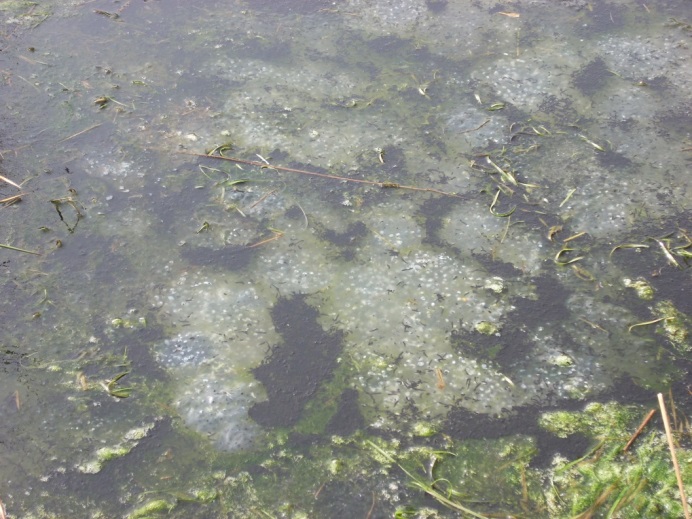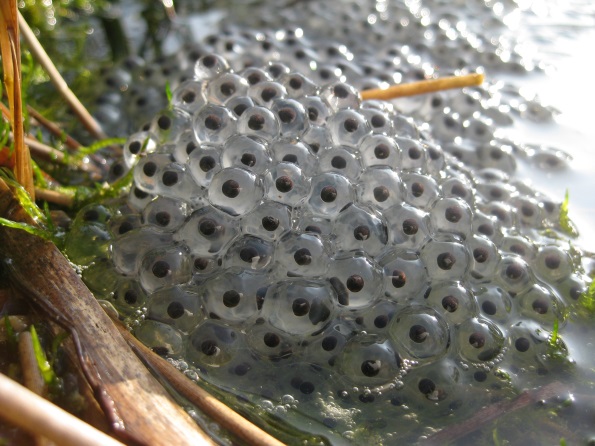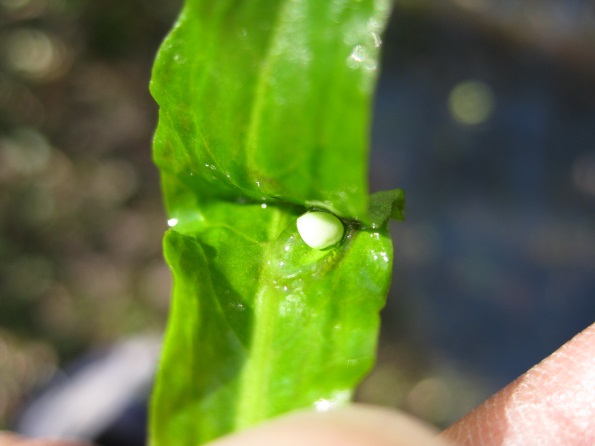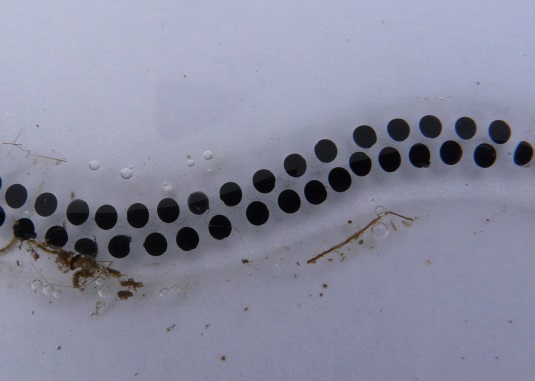Agent
Spawn failure in amphibians occurs when spawn fails to develop properly and consequently doesn’t hatch. Spawn failure may happen simply because the spawn is not fertilised by a male. This may arise due to several factors, for example a low ratio of sexually mature males to females at the breeding site. The failure of fertilised spawn might occur if, for instance, normal embryo development is impeded by environmental factors such as temperature, light, pH, oxygenation and heavy metal concentration in the water. Also, spawn may be predated by newts and other species which can lead to poor hatching rates.
Late frosts or an early warm spell followed by freezing conditions can result in spawn (especially any exposed above the water) to succumb to frost damage, killing the developing eggs.
Studies have shown that exposure to high levels of UV-B light might affect the development of spawn in some species, although no evidence of this has been recorded in Great Britain.
Fungi, such as Saprolegnia spp., can invade spawn that has already died, giving the affected eggs a cotton wool-like appearance. However, studies have also shown that it can be the primary cause of spawn failure in some amphibian species in the USA, usually when that spawn has been weakened by environmental stressors such as UV-B radiation or unusually cool conditions. It is not known if this, or another, water-borne fungus is a primary pathogen of amphibian spawn in Great Britain.
The relative importance of the various causes of amphibian spawn failure in Great Britain is unknown.
Species affected
In Great Britain, spawn failure in amphibians is reported frequently. Species known to have been affected include the common toad (Bufo bufo), the natterjack toad (Epidalea calamita) and the common frog (Rana temporaria).
Signs of disease
The viability of spawn may be assessed by observing the colour of the embryo at the centre of the egg. Dead eggs have a white or grey centre compared to the dark-brown centres that are seen in live eggs. Unfertilised spawn has a normal ‘jelly’-like appearance but fails to develop and may become cloudy and infected with fungus over time. Fungal infection of spawn can result in a white filamentous covering over the spawn which is similar in appearance to cotton wool (see Figure 1).
Figure 1. Dead frog spawn with evidence of fungal invasion, giving the affected eggs a cotton wool-like appearance. (Photo credit: Silviu Petrovan)
Figure 2. Healthy common frog (Rana temporaria) spawn. (Photo credit: Sivi Sivanesan)
Figure 3. Healthy great crested newt (Triturus cristatus) egg. (Photo credit: Sivi Sivanesan)
Figure 4. Healthy common toad (Bufo bufo) spawn. (Photo credit: Rob Williams)
Disease transmission
There is no single recognised cause of amphibian spawn failure. Spawn failure in amphibians is not a feature of infection with ranavirus or chytrid fungus.
Distribution
In Great Britain, reports of amphibian spawn failure are sporadic and usually affect individual sites at any one time.
Risk to human health
No known risk to human health.
Risk to domestic animal health
No known risk to domestic animal health.
Diagnosis
Frog spawn is laid in clumps in shallow water whereas toad spawn is laid in strings, usually wrapped around vegetation in slightly deeper water. Newt eggs are usually found individually wrapped in vegetation. These differences can be used to determine whether frog, toad or newt spawn has been affected (see Figures 2- 4). Spawn consists of a central embryo with a clear jelly-like capsule surrounding it. It is normal to see a pale area in the dark brown embryo if the spawn has just been laid. This area is often observed on the underside of the spawn and gradually turns dark over a few days. Dead eggs have a white or grey centre compared to the dark-brown centres that are seen in live eggs. Unfertilised spawn may be cloudy in appearance and have a white filamentous covering if infected with fungus.
Diagnosing the cause of amphibian spawn failure can be very difficult. This is because spawn failure may occur due to many different factors that were present during the spawn development, but by the time failed spawn is found, the causative agent might have disappeared. Microbiological examination of spawn to diagnose Saprolegnia spp. infections is likely to be unrewarding since this fungus occurs naturally in decaying pond matter and will readily grow on spawn that had died from another cause.
If you wish to report finding a dead amphibian, or signs of disease in amphibians, please visit www.gardenwildlifehealth.org. Alternatively, if you have further queries or have no internet access, please call the Garden Wildlife Health vets on 0207 449 6685.
Control and prevention
If you repeatedly see spawn failure in your pond, improving temperature and light parameters (e.g. by reducing overhanging vegetation causing shade and ensuring varying depths within the pond) may lead to higher hatching rates.
It is important that the movement of spawn between ponds is avoided to reduce the risk of spreading diseases such as ranavirus or chytrid fungus to new areas or ponds.
Further information
Beattie RC, Aston RJ, Milner AGP (1991) A field study of fertilization and embryonic development in the common frog (Rana temporaria) with particular reference to acidity and temperature. Journal of Applied Ecology 28:346–357. doi.org/10.2307/2404134
Kiesecker JM and Blaustein AR (1995) Synergism between UV-B radiation and a pathogen magnifies amphibian embryo mortality in nature. Proceedings of the National Academy of Science USA 99:11049-11052. doi.org/10.1073/pnas.92.24.11049
Robinson J, Griffiths RA, Jeffries P (2003) Susceptibility of frog (Rana temporaria) and toad (Bufo bufo) eggs to invasion by Saprolegnia. Amphibia-Reptilia 24:261–268. doi.org/10.1163/156853803322440745
Acknowledgements
Current funding for the GWH comes in part from Defra, the Welsh Government and the Animal and Plant Agency (APHA) Diseases of Wildlife Scheme (DoWS) http://apha.defra.gov.uk/vet-gateway/surveillance/seg/wildlife.htm; and from the Esmée Fairbairn Foundation, the Universities Federation for Animal Welfare and the Garfield Weston Foundation.
Disclaimer
This fact sheet was produced by Garden Wildlife Health (GWH) for information purposes only. The GWH will not be liable for any loss, damage, cost or expense incurred in or arising by reason of any person relying on information in this fact sheet.
Date of factsheet update:
May 2020




